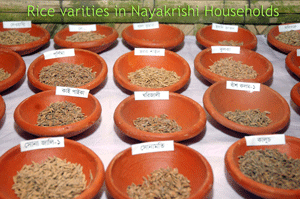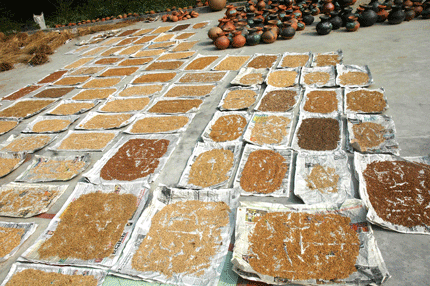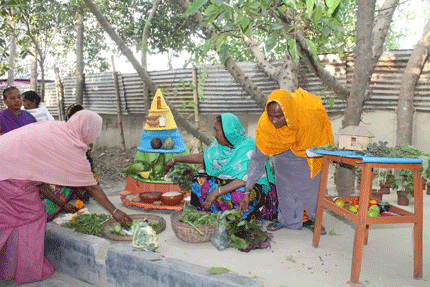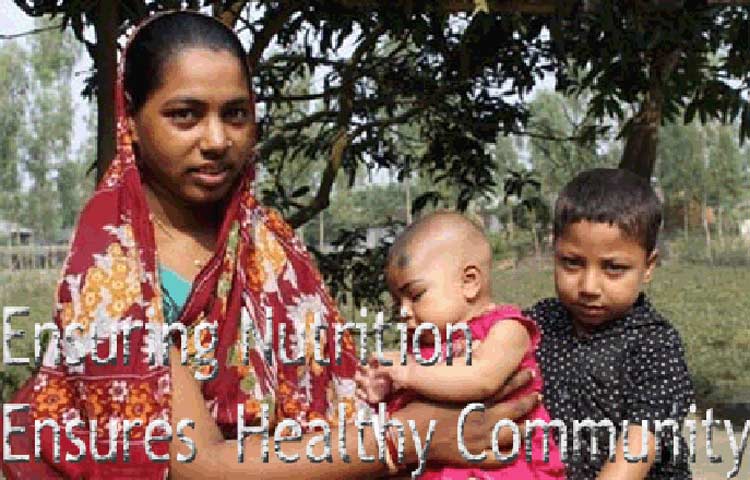Farhad Mazhar and Dr. M. A. Sobhan
‘Currently most research is invested in new technologies rather than in making better use of existing knowledge. Much more research is needed to turn existing knowledge into practical application.’ (WHO 2013)
UBINIG’s commitment to biodiversity-based approaches to agriculture, health and nutrition is based on a critical understanding of various technological approaches to solve some of the major problems of poverty, hunger and malnutrition. Recent interest in biofortification, particularly of staple crops, is of critical interest to UBINIG, particularly to the network of Nayakrishi farmers, Specialized Seed Networks and the network of Dai Mas (traditional birth attendants). All of these networks are firmly grounded on valuable local knowledge and their practice within diverse institutional set up and policy environment. They contribute to develop strong eco-systemic approach to agriculture, health and nutrition integrating social, economic and cultural concerns. Having strong ecological grounds, these community-based movements do not reduce nutrition and hunger only to few deficiencies, but to a holistic approach of ecology, biodiversity, food and life style.
In Bangladesh both chronic and acute malnutrition levels are higher than the WHO’s thresholds for public health emergencies. Micronutrient-related malnutrition is often termed ‘hidden hunger’ as the consequences are not always visible. However, this is a new concept in the context of hunger and malnutrition and is limited to few specific and “defined” deficiencies that are particularly relevant to public health: vitamin A, iron, iodine, and zinc. Nutritional deficiencies are more recognized as part of overall malnutrition problem and believed that a significant proportion of world’s population are suffering from or at risk of deficiencies of vitamins and minerals, commonly referred to as micronutrients. Southeast Asia, (including Bangladesh) is at high risk of Iodine deficiency, Vitamin A and Iron deficiency.
Micronutrient deficiencies are symptoms of a bigger problem. While some urgent measures are necessary, but quick technological fix may derail the priority, focus and achievement of the science and technology in this area; this may knowingly or unknowingly blur our vision from determining factors causing the symptom. To remain alert on this possible lapse valuable local knowledge and practices must be taken into account. The recent World Health Report (2013) has cautioned that “currently most research is invested in new technologies rather than in making better use of existing knowledge. Much more research is needed to turn existing knowledge into practical application” (WHO REPORT 2013). This is a timely warning. UBINIG’s initiative would like to be a link between the procedural knowledge practices and the wealth of experiential knowledge.
Micronutrient deficiencies are responsible for some of the most wide spread and debilitating nutritional disorders, including birth defects, mental and physical retardation, weakened immune systems, blindness and even death. Inadequate consumption of fruits and vegetables, a major reason for such micronutrient deficiencies is estimated to cause about 31 percent of ischemic heart disease and 11 percent of strokes worldwide (World Health Report 2002, reducing risks, promoting healthy life.
Generally it is recognized micronutrients are essential but they are required only in small amounts to benefit human health and nutrition. If properly used, it can significantly contribute to reduce morbidity, malnutrition and mortality. Vitamin A, Iron, Zinc, Iodine, Calcium, Vitamin D and Vitamin B12 are some of the important micronutrients. However, ensuring their availability to the poor is a big challenge and requires a multidisciplinary approach and must go beyond technological solution in order to integrate the front line research in science, i.e., formal knowledge practice.
The diets of the majority people in Bangladesh like many other developing countries are usually dominated by staple foods such as rice, wheat and in some cases maize. However these are mainstream calculations of nutrition and ignore the food intake of the poor people which includes micronutrient foods such as fruits, leafy green vegetables, fish and various known and unknown items from uncultivated food sources. Consumption of micronutrients is also ensured through cultural norms and practices.
Different actors associated with UBINIG are differently interested in micronutrients. The traditional birth attendants, working with very poor and marginal rural families are more interested in nutritional sources that are available in and around the household which people can collect easily. Specialized Seed Network members would like to conserve and regenerate genetic resources that are potential sources of micronutrients. Nayakrishi, the biodiversity-based ecological agriculture, is interested in enhancing farmer’s capacity to select and adopt micronutrient rich crops and engage in research that can develop micronutrient-rich varieties through participatory breeding.


Nayakrishi farmers maintain nearly 2000 varities of rice through Nayakrishi Seed Network. A large number of varieties are also classified by their nutritional value based on the historical experience and local knowledge practices. These information are valuable tool in developing a community nutritional strategy by selecting varieties that must be cultivated to address the nutritional, including micronutrient deficiencies. Farmers are also interested in the development of iron and zinc fortified rice developed by scientists. A collaboration is necessery to make the best use of formal and informal knowledge.
National Micro-nutrient Status in Bangladesh:
The major micronutrients deficiency problems affecting Bangladesh are Vitamin A, Iron, Zinc and iodine according to a survey to assess the Micronutrient deficiency problems affecting Bangladesh. The population of Bangladesh are still well short of the recommended Daily Allowance (RDA) of food intake for the key nutrients. The survey was done i collaboration in 2011-12 in collaboration of ICDDR,B, UNICEF, Bangladesh, Global Alliance for Improved Nutrition (GRAIN) and the Institute of Public Health and Nutrition (IPHN). (see Survey)
Vitamin A
The prevalence of subclinical vitamin A deficiency was 20.5% in the preschool age children; the prevalence was 20.9% and 5.4% respectively in the school age children and the non pregnant non lactating (NPNL) women. The prevalence in the school age children in the slums was 27%.
Iron deficiency
The prevalence of anemia in the preschool age children was 33.1%.The prevalence of anemia in the school age children was 19.1 % and 17.1% respectively in the 6-11 year and 12-14 year groups. The prevalence of anemia in the NPNL women was 26.0%
The national prevalence of iron deficiency was 10.7% in the preschool age children and in the NPNL women it was 7.1%. It was 3.9% and 9.5% in the school age children aged 6-11 year and 12-14 year respectively.
Zinc deficiency
The national prevalence of zinc deficiency was 44.6% in the preschool age children. In the NPNL women the national prevalence was 57.3%. The amount of consumption of zinc was well below the recommended daily amount. Of the total consumption majority comes from plant origin.
B12 and folate:
The B12 and folate status was estimated in the NPNL women. The national prevalence of folate deficiency was 9.1%. The prevalence of B12 deficiency was 23.0% at the national level.
Iodine:
The prevalence of iodine deficiency as measured by the proposition of the school age children whose mean urinary iodine concentration was below the cut-off mark of 100mg/L was 40.0%. In the NPNL women, the prevalence of iodine deficiency was 42.1%. In both the cases iodine deficiency showed a rising trend.
Initiatives to remedy the micronutrient deficiencies
Thera are couple of initiaves based on different approach to address the micronutrient deficiency. Micronutrient Initiative, on international agency based in Canada has been working in some developing countries including Bangladesh since 1997. The organization advocated for and provided funding and technical assistance for salt iodization, distribution of multi-micronutrient powder, staple foods such as flour with vitamin A, iron and folic acid, and dietary supplementation with vitamin A, iron/ zinc and folic acid.

The role of Dai Ma (traditional birth attendant) is key in addressing the micronutrient deficiency in general and mother and child in particular in rural areas. UBINIG has developed a strong network of traditional birth attendants who work closely with Nayakrishi farmers.
Since 2004, Harvest Plus has sought to reduce micronutrient-based malnutrition through bio-fortification. This is a process of breeding new varieties of staple food crops that provide more vitamins and minerals. So far conventional breeding is still the main focus. The Bangladesh Rice Research Institute (BRRI) breeders developed zinc rich rice variety, Brri dhan-62. Harvest plus supported this bio-fortification. Deficiency of zinc in Bangladesh in soil is mainly due to continuous monoculture of aus, aman and boro rice in sequence under wet condition. Thus zinc deficiency is induced due to non-availability of zinc in the soil. The uptake of zinc by Brri dhan 62 in such problematic soil is yet to be seen.
BRRI dhan 62 was developed though hybridization between Jirakateri and BRRI dhan 39. It was advanced through pedigree selection and released through the National Seed Board (NSB) in 2013. It was released for cultivation in aman season. It has a crop duration of 100 days from seed to seed. Average yield 3.5 – 4.5 t/ha. The grains contain 19 mg/kg of zinc. A lot of reseach is yet to be done to translate the laboratory success into effective nutritional success. Nevertheless, the success of Brri dhan 62 demonstatrates the capacity of Bangladeshi scientists to take up the challenge of breeding new varieties with higher nutritional value. (www.knoledgebank-brri.org/Rice-Production – Training – Manual/Day-1/Module – 2/ Aman / BRRI – Dhan 62.pdf).
However, the availability of zinc decreases due to submergence, which may be challenge to ensure uptake of zinc by the rice plant during the aman season. This is attributed to the following reasons:
1. Formation of insoluble franklinite (ZnFe2O4) compound in submerged soil. Zn2+ +2Fe2+ +4H2o >< zn Fe2 O4 (insoluble)
2. Formation of very insoluble compounds of Zn as sphalerite (Zns) under intense reducing conditions.
Zn +2 +S2- >< Zns (insoluble)
3. Formation of insoluble compounds of of Zn as ZnCo3 at the later period of soil submergence due to high partial pressure of CO2 arising from the decomposition of organize matter 2n2+ + Co2 > < 2n Co3 (Insoluble)
4. Formation of Zn (oH)2 at a reactively higher pH which decreases the availability of Zn. Zn2+ +2OH >< Zn(OH)2 insoluble
5. Adsorption of soluble Zn2+ by oxides, hydrous oxide organic matter carbonates, sulphates, clay minerals etc. decreases the availability of Zn.
6. Formation of other insoluble zinc compounds which decreases the availability of Zn in submerged soils, e.g. high phosphatic fertilizer induces the decreased availability zinc. Zn2+ +Po43- >< Zn3 (Po4)2 (insoluble)
(see Das, D K. 1996, Transformation of different fractions of zinc in submerged soil as affected by the application of nitrogen. Crop Res 11:53-61.)
Iron and zinc content of local varieties of rice in Bangladesh
For Nayakrishi, the research on the nutritional content of local rice varieties is critical and more urgent since they can be basis of ecological design to promote these varieties and encourage consumption. Some available information on the micronutritional content of local rice varieties are provided below.
Table 1: Iron and zinc content of local non-aromatic rice varieties

Table 2: Iron and zinc content of local aromatic rice varieties

Surce (www.ifpri.org/sites/default/files/publications/alleviatging mal.pdf)
Iron and zinc content of high yielding varieties of rice in Bangladesh
Table 3: Iron and Zinc content of high yielding non-aromatic rice varieties

Source: www.ifpri.org/sites/default/files/publications/alleviatingmal.pdf
Alleviating malnutrition through agriculture in Bangladesh: bio-fortification and diversification as sustainable solutions:
Homestead food production (HFP) program is a familiar approach to solve micronutrient deficiency. National and international NGOs have promoted an integrated package of home gardening, small livestock production and nutrition education. It helped to increase household production, availability and consumption of micronutrient rich food. HFP has proved to be an effective approach to improved food and nutritional security for vulnerable people in diverse agro-ecological zones. This has been achieved through increased production and consumption of micronutrient rich foods, increased income from gardens and reduced expenditures on micronutrient rich foods. women’s empowerment enhanced partner capacity and community development (www.ifpris org/million,fed).
Agroecological Challenges
Micronutrient deficiency in soils is a fast emerging phenomenon and a challenging abiotic stress in agriculture. Most important micronutrients that the developing and enveloped world is concerned from point of view of sustaining grain productivity and malnutrition in human beings are iron and zinc. Bio-fortification of staple food crops with micronutrient by either breeding for higher uptake efficiency or fertilization can be an effective strategy to address widespread dietary deficiency in human population. Cereal species greatly differ in their micronutrient efficiency. Root morphology and characteristics and interaction between micronutrients and other ionic radicals have been implicated as determinants of micronutrient efficiency.
Agricultural crops in general, require 16 essential elements for their growth and development. The elements include carbon(C) , hydrogen (H) and oxygen (0), which are derived from air and water and comprise 94.0 to 99.5% of the fresh plant tissue. The remaining nutrients used by plants come from soil in the form of inorganic salts. Depending on their requirement for plant metabolism the nutrients are classified as macro and micronutrients. The macronutrients such as nitrogen (N), phosphorus (P), potassium (K), calcium (Ca), magnesium (Mg) and sulphur (S), are taken up by plants either from native minerals or from fertilizer applied to soil. Legumes are an exception because they can also fix nitrogen from the air. There are some other essential elements that are needed by plants in relatively small amount- micronutrients i.e., iron (Fe), zinc (Zn), boron (B), chlorine (cl), copper (Cu), manganese (Mn) and molybdenum (Mo). Crops, in general vary considerably in their response to various micronutrients.
(see Bhupender Singh, Sena Nayak Dheeravathu, Kalidindi usha. 2010. Micronutrient Deficiency: A Global Challenge and Physisological Approach to Improve Grain Productivity under Low Zinc Availability. Global Science Books, Krishikosh. egranth.ac. in/bit stream/1/40186/1/ NAPS-27-2009.)

Traditional Birth Attendants are demonstrating the nutritional value of different food crops by arranging the criops in a pyramid. A powerful and visual way to educate the rural people.
Soil pH is one of the most important factors affecting the availability of micronutrients to plants. The availability of micronutrient , in general, is reduced at high pH, with exception of Mo whose availability increases as soil pH increases.
Bangladesh agriculture is now standing at a critical stage. The conventional agriculture spear headed by the green revolution has made significant improvement of harvest index but at the same time led to degradation of natural resources. This development was focused on monoculture of selected food grains and other commercial crops. Consequently the supply of food grains has increased substantially. On the other hand, the supply of non-staple food like pulses, vegetables, fruits, animal products and fish has fallen back. Now it is reflected that micronutrient malnutrition has been affecting a significant proportion of population, mainly women and children. Thus adequate supply of minerals and vitamins is a dire need of time for ensuring food sovereignty. The situation is more critical in case of zinc, iron, beta-carotene (vitamin A) and iodine.
The conventional planners were optimistic that commercial fortification and supplementation would be effective for reduction of micronutrient malnutrition. Very soon the approach proved to be cost prohibitive and unsustainable. The second thought was targeted to biofortification of major staples. To that end rice was chosen for Bangladesh. Bangladesh Rice Research Institute (BRRI) under the patronization of Harvest Plus developed BRRI dhan 62. Yet, the problems remains that zinc decreases due to submergence.
The charismatic idea of solving zinc deficiency with biofortification of rice through conventional breeding or genetic modification remains illusive. The solution probably lies in a holistic approach of ecological agriculture.
Nayakrishi Andolon, Bangladesh
While Nayakrishi is eager to learn from the experience of various other approaches to use agriculture as a means to solve micronutritional deficiency, our primary premise is that conservation of ecology and biodiversity and thus ensuring nutritional plants and crops in and around the household is the key frame within which all different approaches should be tested to maximize the benefit of different approaches, if the policy makers are indeed committed to eliminate hidden hunger. It means in order to address micro-nutrient deficiencies among the people in Bangladesh, the biodiversity-based farming practice should be promoted. Such farming practice is popularly called the Nayakrishi Andolon (New Agricultural Movement. It presents a holistic approach to solving the hunger, malnutrition and particularly micro-nutrient deficiencies. Over 300,000 farming households are involved in the movement and are contributing to the solution of hunger and malnutrition.
As a movement for ecological agriculture, it is based on principles like no use of chemicals, soil management through recycling of local resources rather than using chemical fertilizer, the practice of mixed cropping, crop rotation and reduction of risk due to crop failure. The central approach of the system lies in the conservation, management and use of local seed and genetic resources. Thus hundreds of crops have been maintained. More importantly Nayakrishi believes in building the capacity of the farmers to solve their nutrition problem and thereby gives more importance to seed preservation and networking among the farmers.
The Nayakrishi Seed Network (NSN) is the active farmers’ network with specific responsibility for ensuring both in situ and ex situ conservation at the household and community levels. The precise responsibility of NSN is to ensure collecting, conservation, distribution and enhancement of germplasm among the members of Nayakrishi Andolon. The seed conservation activities take into account the particular ecological feature of villages. It is the ecological feature, therefore, determine the clustering for NSN, not the administrative boundary of the village. NSN identifies varieties with high nutritional value and promote theme to the farmers.
The NSN builds on the farming households, the nodal interactive point for in situ and ex situ conservation. Farmers maintain diversity in the field, but at the same time conserve seed in their homes for several years to be replanted in the coming seasons. The NSN is established in different villages. The strategy of Nayarkishi Andolon in the maintenance of biodiversity is based on some simple rules and obligations among the members. These are:
1. To remain as an active group members of Nayakrishi Andolon, a farming house hold has to always inform the group of planting decisions and plans for each season.
2. Members should harvest seeds collectively, if possible, to make sure that all the valuable seeds of the village have been collected and conserved at the household level and that the quality of the seeds maintained under the leadership of experienced farmers in the village.
3. If seeds of household are destroyed for any reason, the village leader should be informed and must immediately replenish from other group members or from the CSWC (Community Seed Wealth Center).
4. If farming household is not replanting a variety one year they are obliged as members to give it to a neighbor and make sure that neighbor replants the variety and both collect seeds for the next season.
5. If a farming household does not find anyone to replant a variety, they are obliged to report to the Nayakrishi Seed Network and deposit the seeds, if necessary in the CSWC.
Seed conservation is an art that largely belongs to women. The leadership of women farmers in seed conservation and Community Seed Wealth Centers is almost natural. Women, therefore, are the key elements in building up a national seed network. They are the key actors and leaders in the operation of the NSN. In addition, Nayakrishi Andolon has formed a Specialized Women Seed Network (SWSN) comprised solely of women farmers.
The NSN is also linked with Nayakrishi Seed Huts (NSH), households in a village specializing in maintenance of local crop varieties and Community Seed Wealth Canters acting as Community Seed Banks (books. google. com.bd/books? isbn=9290434449, Esbern Friis-Hanson, Bhuwon Sthapit-2000-Agriculture).
The NSN is structured in following way:
Nayakrishi Seed Huts: From the individual farmer’s seed collection at the household level, Nayakrishi Seed Hut is established by the independent initiative of one or two households in the village belonging to Nayakrishi Andolon, who are willing to take responsibility to ensure that all common species and varieties are replanted, regenerated and conserved by the farmers. These households are known as Nayakrishi Seed Huts (NSH).
Specialized Women Seed Network: To enhance the capacity of the community the Specialized Women Seed Network (SWSN) has been formed. These are the women who are specialized in certain species or certain varieties. Their task is to collect local varieties from different parts of Bangladesh. They also monitor and document introduction of a variety in a village or locality. They keep the information up to date about the variability of species for which they are assigned. The SWSN often shares their findings in large meeting organized by the Nayakrishi Andolon.
Community Seed Wealth Center: Community Seed Wealth Center (CSWC) is the institutional set up in the village that articulates the relation between village and the National Gene Banks. The CSWC also maintains a well-developed nursery. The construction of CSWCS is based on two principles (a) they must be built from locally available construction materials and (b) the maintenance should mirror the household seed conservation practices. Any difficulty encountered in the CSWC reflects the problems farmers are facing in their household conservation. Any members of the Nayakrishi Andolon can collect seed from CSWC with the promise that they will deposit double the quantity they received after the harvest. More than 300 000 households in 677 villages in 166 unions in 73 upazilas in 19 districts are directly covered by the NSN.
Community Food System in Nayakrishi
A Field study carried out by UBINIG in Badarkhali Union of Chokoria Thana & Shaplapur Union of Maheshkhali Cox’s Bazar District revealed that the Nayakrishi community members consumed 153 food items. The food item were divided into five food groups including : (1) vegetables , (2) Fruits, (3) Cereal, grains and pulses, (4) meats, (5) fish and sea foods. These items were regular sources of macro and micronutrients including Beta carotene, zinc and iron (www.mcgill.ca/cine/resources/data/bangladesh).
Uncultivated food source in Bangladesh:
The importance of uncultivated food source in the survival strategies of the poor people is quite well known in the villages of Bangladesh. But what is the nature of this contribution? Collecting information on how poor people survive is not easy. It is even difficult to find them at home when we go looking for them. In the village when we ask, “where are they” the answer that come back is “chak” meaning they are in the open fields or out there, collecting her family’s daily nourishment from the roadside government lands or from the private land of others. The uncultivated food sources include leafy greens, fish, fruit, roots and tubers (www.mtnforum.or/sites/default/files/publication/files/3669.pdf).
Uncultivated food sources make up at least 40% of the daily diet. Far from being a minor supplement the leafy greens, tubers and small fish collected by people are a vital part of the daily diet. This particular aspect is a contribution of women to ensuring food sovereignty of the family and the community (commons.In.edu.hk/cgi/viewcontent.cgi?article = 1092 & context – by M HUQ-2011).

Nayakrishi farmers are showing varieties of uncultivated leafy green full with micronutrients and exceelnt to deal with nutritional deficiency i the village.
Women have the knowledge of seasonal crops, vegetables, fruits, fish and other food through sources of plants and animal, how they can solve specific nutrition deficiencies. Village family with monoculture crops and in the areas where non-food crop such as tobacco is grown suffer from such deficiencies more than the Nayakrishi village. Nayakrishi ensures not only food security but also nutritional security that includes micronutrient deficiences.
